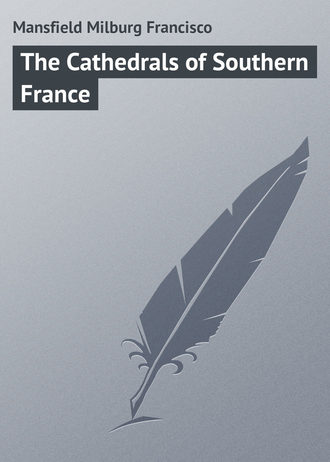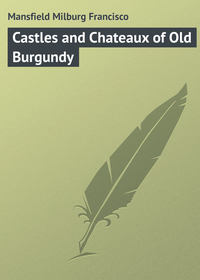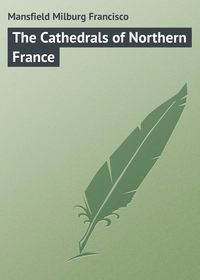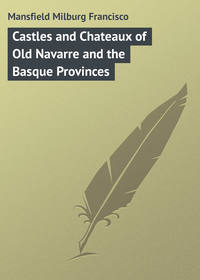 полная версия
полная версияThe Cathedrals of Southern France
The ancient cathedral of St. Apollinaire is almost wholly conceived and executed in what has come to be known as the Lombard style.
The main body of the church is preceded on the west by an extravagant rectangular tower, beneath which is the portal or entrance; if, as in the present instance, the comprehensive meaning of the word suggests something more splendid than a mere doorway.
There has been remarked before now that there is a suggestion of the Corinthian order in the columns of both the inside and outside of the church. This is a true enough detail of Lombard forms as it was of the Roman style, which in turn was borrowed from the Greeks. In later times the neo-classical details of the late Renaissance period produced quite a different effect, and were in no way comparable to the use of this detail in the Lombard and Romanesque churches.
In St. Apollinaire, too, are to be remarked the unusual arch formed of a rounded trefoil. This is found in both the towers, and is also seen in St. Maurice at Vienne, but not again until the country far to the northward and eastward is reached, where they are more frequent, therefore their use here may be considered simply as an interpolation brought from some other soil, rather than an original conception of the local builder.
Here also is seen the unusual combination of an angular pointed arch in conjunction with the round-headed Lombard variety. This, in alternation for a considerable space, on the south side of the cathedral. It is a feature perhaps not worth mentioning, except from the fact that both the trefoil and wedge-pointed arch are singularly unbeautiful and little in keeping with an otherwise purely southern structure.
The aisles of St. Apollinaire, like those of Notre Dame de la Grande at Poitiers, and many other Lombardic churches, are singularly narrow, which of course appears to lengthen them out interminably.
If any distinctive style can be given this small but interesting cathedral, it may well be called the style of Lyonnaise.
It dates from the twelfth century as to its foundations, but was rebuilt on practically a new ground-plan in 1604.
To-day it is cruciform after the late elongated style, with lengthy transepts and lofty aisles.
The chief feature to be observed of its exterior is its heavy square tower (187 feet) of four stories. It is not beautiful, and was rebuilt in the middle nineteenth century, but it is imposing and groups satisfactorily enough with the ensemble round about. Beneath this tower is a fine porch worked in Crussol marble.
There is no triforium or clerestory. In the choir is a cenotaph in white marble to Pius VI., who was exiled in Valence, and who died here in 1799. It is surmounted by a bust by Canova, whose work it has become the fashion to admire sedulously.
VII
CATHÉDRALE DE VIVIERS
The bishopric of Viviers is a suffragan of Avignon, and is possessed of a tiny cathedral church, which, in spite of its diminutive proportions, overtops quite all the other buildings of this ancient capital of the Vivarais.
The city is a most picturesque setting for any shrine, with the narrow, tortuous streets – though slummy ones – winding to the cliff-top on which the city sits high above the waters of the Rhône.
The choir of this cathedral is the only portion which warrants remark. It is of the fourteenth century, and has no aisles. It is in the accepted Gothic style, but this again is coerced by the Romanesque flanking tower, which, to all intents and purposes, when viewed from afar, might well be taken for a later Renaissance work.
A nearer view dissects this tower into really beautiful parts. The base is square, but above – in an addition of the fifteenth century – it blooms forth into an octagon of quite original proportions.
In the choir are some Gobelin tapestries and paintings by Mignard; otherwise there are no artistic attributes to be remarked.
VIII
NOTRE DAME D'ORANGE
The independent principality of Orange (which had existed since the eleventh century), with the papal State of Avignon, the tiny Comté Venaissin, and a small part of Provence were welded into the Department of Vaucluse in the redistribution of political divisions under Napoleon I. The house of Nassau retains to-day the honorary title of Princes of Orange, borne by the heir apparent to the throne of Holland. More anciently the city was known as the Roman Arausio, and is yet famous for its remarkable Roman remains, the chief of which are its triumphal arch and theatre – one of the largest and most magnificent, if not actually the largest, of its era.
The history of the church at Orange is far more interesting and notable than that of its rather lame apology for a cathedral of rank. The see succumbed in 1790 in favour of Avignon, an archbishopric, and Valence, one of its suffragans.
The persecution and oppression of the Protestants of Orange and Dauphiné are well-recorded facts of history.
A supposedly liberal and tolerant maker of guide-books (in English) has given inhabitants of Orange a hard reputation by classing them as a "ferocious people." This rather unfair method of estimating their latter-day characteristics is based upon the fact that over three hundred perished here by the guillotine during the first three months of the Revolution. It were better had he told us something of the architectural treasures of this ville de l'art célèbre. He does mention the chief, also that "the town has many mosquitoes," but, as for churches, he says not a word.
The first bishop was St. Luce, who was settled here in the fourth century, at the same time that St. Ruff came to Avignon.
As a bishopric, Orange was under the control of St. Trophime's successors at Arles.
Notre Dame d'Orange is a work of little architectural pretence, though its antiquity is great as to certain portions of its walls. The oldest portion dates from 1085, though there is little to distinguish it from the more modern additions and reparations, and is in no way suggestive of the splendour with which the ancient Roman theatre and arch were endowed.
The chief attribute to be remarked is the extreme width of nave, which dates from 1085 to 1126. The cathedral itself, however, is not an architectural example of any appealing interest whatever, and pales utterly before the magnificent and splendid preservations of secular Roman times.
Since, however, Orange is a city reminiscent of so early a period of Christianity as the fourth century, it is to be presumed that other Christian edifices of note may have at one time existed: if so, no very vivid history of them appears to have been left behind, and certainly no such tangible expressions of the art of church-building as are seen in the neighbouring cities of the Rhône valley.
IX
ST. VÉRAN DE CAVAILLON
"It is the plain of Cavaillon which is the market-garden of Avignon; from whence come the panniers of vegetables and fruits, the buissons d'artichauts, and the melons of 'high reputation.'"
Such is the rather free paraphrase of a most charmingly expressed observation on this Provençal land of plenty, written by an eighteenth-century Frenchman.
If it was true in those days, it is no less true to-day, and, though this book is more concerned with churches than with potagerie, the observation is made that this fact may have had not a little to do with the early foundation of the church, here in a plenteous region, where it was more likely to prosper than in an impoverished land.
The bishopric was founded in the fifth century by St. Genialis, and it endured constantly until the suppression in 1790.
All interest in Cavaillon, in spite of its other not inconsiderable claims, will be centred around its ancient cathedral of St. Véran, immediately one comes into contact therewith.
The present structure is built upon a very ancient foundation; some have said that the primitive church was of the seventh century. This present cathedral was consecrated by Pope Innocent IV. in person, in 1259, and for that reason possesses a considerable interest which it would otherwise lack.
Externally the most remarkable feature is the arrangement and decoration of the apside – there is hardly enough of it to come within the classification of the chevet. Here the quintuple flanks, or sustaining walls, are framed each with a pair of columns, of graceful enough proportions in themselves, but possessed of inordinately heavy capitals.
An octagonal cupola, an unusual, and in this case a not very beautiful feature, crowns the centre of the nave. In reality it serves the purpose of a lantern, and allows a dubious light to trickle through into the interior, which is singularly gloomy.
To the right of the nave is a curiously attenuated clocher, which bears a clock-face of minute proportions, and holds a clanging bourdon, which, judging from its voice, must be as proportionately large as the clock-face is small.
Beneath this tower is a doorway leading from the nave to the cloister, a beautiful work dating from a much earlier period than the church itself.
This cloister is not unlike that of St. Trophime at Arles, and, while plain and simple in its general plan of rounded arches and vaulting, is beautifully worked in stone, and admirably preserved. In spite of its severity, there is no suggestion of crudity, and there is an elegance and richness in its sculptured columns and capitals which is unusual in ecclesiastical work of the time.
The interior of this church is quite as interesting as the exterior. There is an ample, though aisleless, nave, which, though singularly dark and gloomy, suggests a vastness which is perhaps really not justified by the actual state of affairs.
A very curious arrangement is that the supporting wall-pillars – in this case a sort of buttress, like those of the apside – serve to frame or enclose a series of deep-vaulted side chapels. The effect of this is that all of the flow of light, which might enter by the lower range of windows, is practically cut off from the nave. What refulgence there is – and it is not by any means of the dazzling variety – comes in through the before-mentioned octagon and the upper windows of the nave.
In a chapel – the gift of Philippe de Cabassole, a friend of Petrarch's – is a funeral monument which will even more forcibly recall the name and association of the poet. It is a seventeenth-century tomb of Bishop Jean de Sade, a descendant of the famous Laura, whose ashes formerly lay in the Église des Cordeliers at Avignon, but which were, it is to be feared, scattered to the winds by the Revolutionary fury.
At the summit of Mont St. Jacques, which rises high above the town, is the ancient Ermitage de St. Véran; a place of local pilgrimage, but not otherwise greatly celebrated.
X
NOTRE DAME DES DOMS D'AVIGNON
It would be difficult to say with precision whether Avignon were more closely connected in the average mind with the former papal splendour, with Petrarch and his Laura, or with the famous Félibrage.
Avignon literally reeks with sentimental associations of a most healthy kind. No probable line of thought suggested by Avignon's historied and romantic past will intimate even the mawkish, the sordid, or the banal. It is, in almost limitless suggestion, the city of France above all others in which to linger and drink in the life of its past and present to one's fullest capacities.
For the "literary pilgrim," first and foremost will be Avignon's association with Petrarch, or rather he with it. For this reason it shall be disposed of immediately, though not in one word, or ten; that would be impossible.
"'The grave of Laura!' said I. 'Indeed, my dear sir, I am obliged to you for having mentioned it,'" were the words with which the local bookseller was addressed by an eighteenth-century traveller. "'Otherwise one might have gone away, to their everlasting sorrow and shame, without having seen this curiosity of your city.'"
The same record of travel describes the guardian of this shrine as "a converted Jew, who, from one year's end to another, has but two duties to perform, which he most punctually attends to. The one to take care of the grave of Laura, and to show it to strangers, the other to give them information respecting all the curiosities. Before his conversion, he stood at the corner by the Hôtel de Ville offering lottery tickets to passers-by, and asking, till he was hoarse, if they had anything to sell. Not a soul took the least notice of him. His beard proved a detriment in all his speculations. Now that he has become a Christian, it is wonderful how everything thrives with him."
At the very end of the Rue des Lices will be found the last remains of the Église des Cordeliers – reduced at the Revolution to a mere tower and its walls. Here may be seen the spot where was the tomb of Laura de Sade. Arthur Young, writing just before the Revolution, described it as below; though since that time still other changes have taken place, with the result that "Laura's Grave" is little more than a memory to-day, and a vague one at that.
"The grave is nothing but a stone in the pavement, with a figure engraved on it already partly effaced, surrounded by an inscription in Gothic letters, and another on the wall adjoining, with the armorial bearings of the De Sade family."
To-day nothing but the site – the location – of the tomb is still there, the before-mentioned details having entirely disappeared. The vault was apparently broken open at the Revolution, and its ashes scattered. It was here at Avignon, in the Église de St. Claire, as Petrarch himself has recorded, that he first met Laura de Sade.
The present mood is an appropriate one in which to continue the Petrarchian pilgrimage countryward – to the famous Vaucluse. Here Petrarch came as a boy, in 1313, and, if one chooses, he may have his déjeuner at the Hôtel Pétrarque et Laure; not the same, of course, of which Petrarch wrote in praise of its fish of Sorgues; but you will have them as a course at lunch nevertheless. Here, too, the famed Fontaine first comes to light and air; and above it hangs "Petrarch's Castle," which is not Petrarch's castle, nor ever was. It belonged originally to the bishops of Cavaillon, but it is possible that Petrarch was a guest there at various times, as we know he was at the more magnificent Palais des Papes at Avignon.
This château of the bishops hangs perilously on a brow which rises high above the torrential Fontaine, and, if sentiment will not allow of its being otherwise ignored, it is permissible to visit it, if one is so inclined. No special hardship is involved, and no great adventure is likely to result from this journey countryward. Tourists have been known to do the thing before "just to get a few snapshots of the fountain."
As to why the palace of the popes came into being at Avignon is a question which suggests the possibilities of the making of a big book.
The popes came to Avignon at the time of the Italian partition, on the strength of having acquired a grant of the city from Joanna of Naples, for which they were supposed to give eighty thousand golden crowns. They never paid the bill, however; from which fact it would appear that financial juggling was born at a much earlier period than has hitherto been supposed.
Seven popes reigned here, from 1305 to 1370; when, on the termination of the Schism, it became the residence of a papal legate. Subsequently Louis XIV. seized the city, in revenge for an alleged affront to his ambassador, and Louis XV. also held it for ten years.
The curious fact is here recalled that, by the treaty of Tolentino (12th February, 1797), the papal power at Rome conceded formally for the first time – to Napoleon I. – their ancient territory of Avignon. On the terms of this treaty alone was Pope Pius allowed to remain nominal master of even shreds of the patrimony of St. Peter.
The significant events of Avignon's history are too great in purport and number to be even catalogued here, but the magnificent papal residence, from its very magnitude and luxuriance, compels attention as one of the great architectural glories, not only of France, but of all Europe as well.
Here sat, for the major portion of the fourteenth century, the papal court of Avignon; which the uncharitable have called a synonym for profligacy, veniality, and luxurious degeneracy. Here, of course, were held the conclaves by which the popes of that century were elected; significantly they were all Frenchmen, which would seem to point to the fact of corruption of some sort, if nothing more.
Rienzi, the last of the tribunes, was a prisoner within the walls of this great papal stronghold, and Simone Memmi of Sienna was brought therefrom to decorate the walls of the popes' private chapel; Petrarch was persona grata here, and many other notables were frequenters of its hospitality.
The palace walls rise to a height of nearly ninety feet, and its battlemented towers add another fifty; from which one may infer that its stability was great; an effect which is still further sustained when the great thickness of its sustaining walls is remarked, and the infrequent piercings of windows and doorways.
This vast edifice was commenced by Pope Clement V. in the early years of the thirteenth century, but nothing more than the foundations of his work were left, when Benedict XII., thirty years later, gave the work into the hands of Peter Obreri – who must have been the Viollet-le-Duc of his time.
Revolution's destroying power played its part here, as generally throughout France, in defacing shrines, monuments, and edifices, civil and ecclesiastical, with little regard for sentiment and absolutely none for reason.
The mob attacked the papal palace with results more disastrous than the accumulated debasement of preceding centuries. The later régime, which turned the magnificent halls of this fortress-like palace into a mere barracks – as it is to-day – was quite as iconoclastic in its temperament.
One may realize here, to the full, just how far a great and noble achievement of the art and devotion of a past age may sink. The ancient papal palace at Avignon – the former seat of the power of the Roman Catholic religion – has become a mere barracks! To contemplate it is more sad even than to see a great church turned into a stable or an abattoir – as can yet be seen in France.
In its plan this magnificent building preserves its outlines, but its splendour of embellishment has very nearly been eradicated, as may be observed if one will crave entrance of the military incumbent.
In 1376 Pope Gregory XI. left Avignon for Rome, – after him came the two anti-popes, – and thus ended what Petrarch has called "L'Empia Babilonia."
The cathedral of Notre Dame des Doms pales perceptibly before the splendid dimensions of the papal palace, which formerly encompassed a church of its own of much more artistic worth.
In one respect only does the cathedral lend a desirable note to the ensemble. This, by reason of its commanding situation – at the apex of the Rocher des Doms – and by the gilded statue of the Virgin which surmounts the tower, and supplies just the right quality of colour and life to a structure which would be otherwise far from brilliant.
From the opposite bank of the Rhône – from Villeneuve-les-Avignon – the view of the parent city, the papal residence, the cathedral, and that unusual southern attribute, the beffroi, all combine in a most glorious picture of a superb beauty; quite rivalling – though in a far different manner – that "plague spot of immorality," – Monte Carlo, which is mostly thought to hold the palm for the sheer beauty of natural situation.
The cathedral is chiefly of the twelfth century, though even a near-by exterior view does not suggest any of the Gothic tendencies of that era. It is more like the heavy bungling style which came in with the Renaissance; but it is not that either, hence it must be classed as a unique variety, though of the period when the transition from the Romanesque to Gothic was making inroads elsewhere.
It has been said that the structure dates in part from the time of Charlemagne, but, if so, the usual splendid appointments of the true Charlemagnian manner are sadly lacking. There may be constructive foundations of the eleventh century, but they are in no way distinctive, and certainly lend no liveliness to a building which must ever be ranked as unworthy of the splendid environment.
As a church of cathedral rank, it is a tiny edifice when compared with the glorious northern ground-plans: it is not much more than two hundred feet in length, and has a width which must be considerably less than fifty feet.
The entrance, at the top of a long, winding stair which rises from the street-level of the Place du Palais to the platform of the rock, is essentially pagan in its aspect; indeed it is said to have previously formed the portal of a pagan temple which at one time stood upon the site. If this be so, this great doorway – for it is far larger in its proportions than any other detail – is the most ancient of all the interior or exterior features.
The high pediment and roof may be pointed Gothic, or it may not; at any rate, it is in but the very rudimentary stage. Authorities do not agree; which carries the suggestion still further that the cathedral at Avignon is of itself a queer, hybrid thing in its style, and with not a tithe of the interest possessed by its more magnificent neighbour.
The western tower, while not of great proportions, is rather more massive than the proportions of the church body can well carry. What decoration it possesses carries the pagan suggestion still further, with its superimposed fluted pillars and Corinthian columns.
The gloomy interior is depressing in the extreme, and whatever attributes of interest that it has are largely discounted by their unattractive setting.
There are a number of old paintings, which, though they are not the work of artists of fame, might possibly prove to be of creditable workmanship, could one but see them through the gloom. In the before-mentioned porch are some frescoes by Simone Memmi, executed by him in the fourteenth century, when he came from Sienna to do the decorations in the palace.
The side chapels are all of the fourteenth century; that of St. Joseph, now forming the antechamber of the sacristy, contains a noteworthy Gothic tomb and monument of Pope John XXII. It is much mutilated to-day, and is only interesting because of the personality connected therewith. The custodian or caretaker is in this case a most persistently voluble person, who will give the visitor little peace unless he stands by and hears her story through, or flees the place, – which is preferable.
The niches of this highly florid Gothic tomb were despoiled of their statues at the Revolution, and the recumbent effigy of the Pope has been greatly disfigured. A much simpler monument, and one quite as interesting, to another Pope, Benedict XII., – he who was responsible for the magnificence of the papal palace, – is in a chapel in the north aisle of the nave, but the cicerone has apparently no pride in this particular shrine.
An ancient (pagan?) altar is preserved in the nave. It is not beautiful, but it is undoubtedly very ancient and likewise very curious.
The chief accessory of interest for all will doubtless prove to be the twelfth-century papal throne. It is of a pure white marble, rather cold to contemplate, but livened here and there with superimposed gold ornament. What decoration there is, chiefly figures representing the bull of St. Luke and the lion of St. Mark, is simple and severe, as befitted papal dignity. To-day it serves the archbishop of the diocese as his throne of dignity, and must inspire that worthy with ambitious hopes.
The chapter of the cathedral at Avignon – as we learn from history – wears purple, in company with cardinals and kings, at all celebrations of the High Mass of Clara de Falkenstein. From a well-worn vellum quarto in the library at Avignon one may read the legend which recounts the connection of Ste. Clara de Mont Falcone with the mystery of the Holy Trinity; from which circumstance the honour and dignity of the purple has been granted to the prelates of the cathedral.









